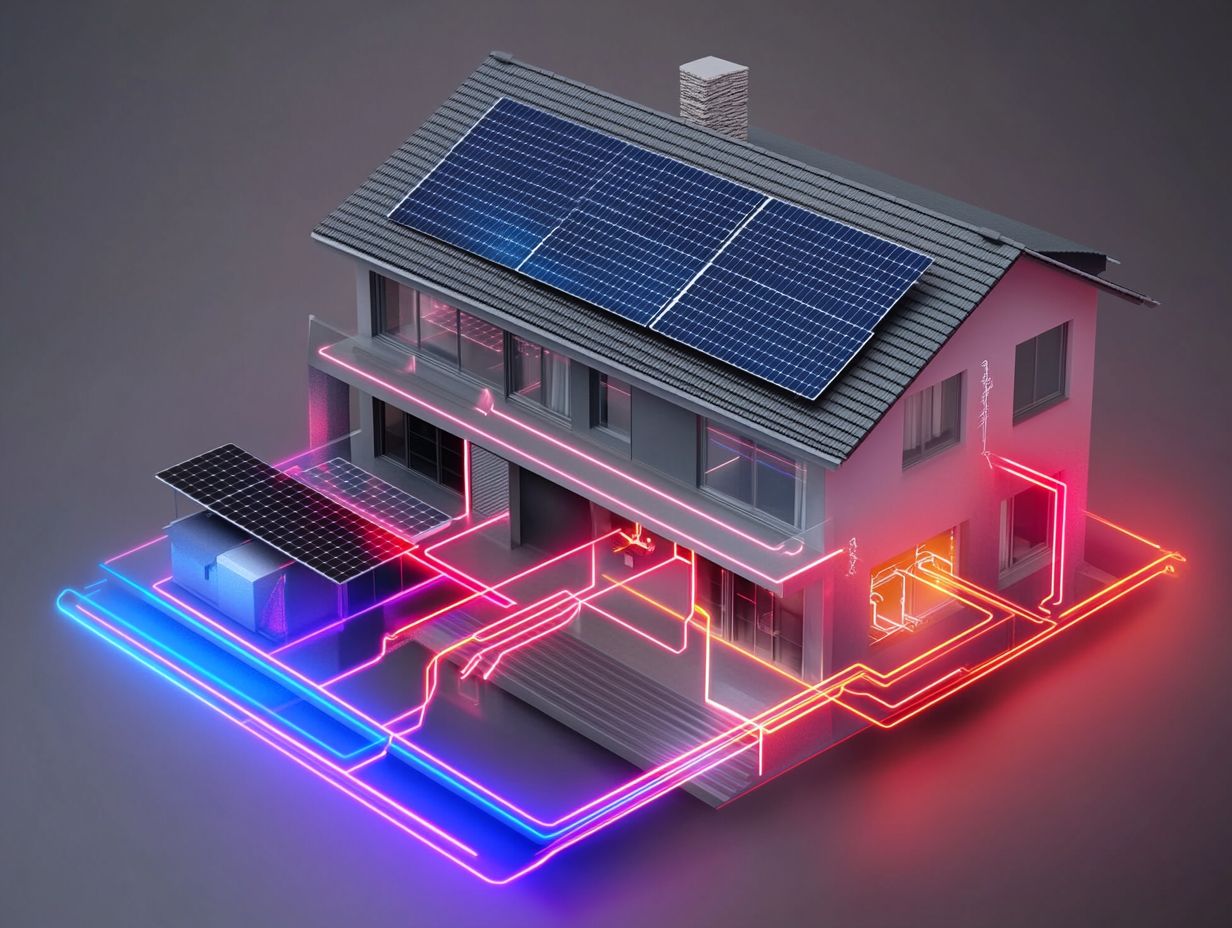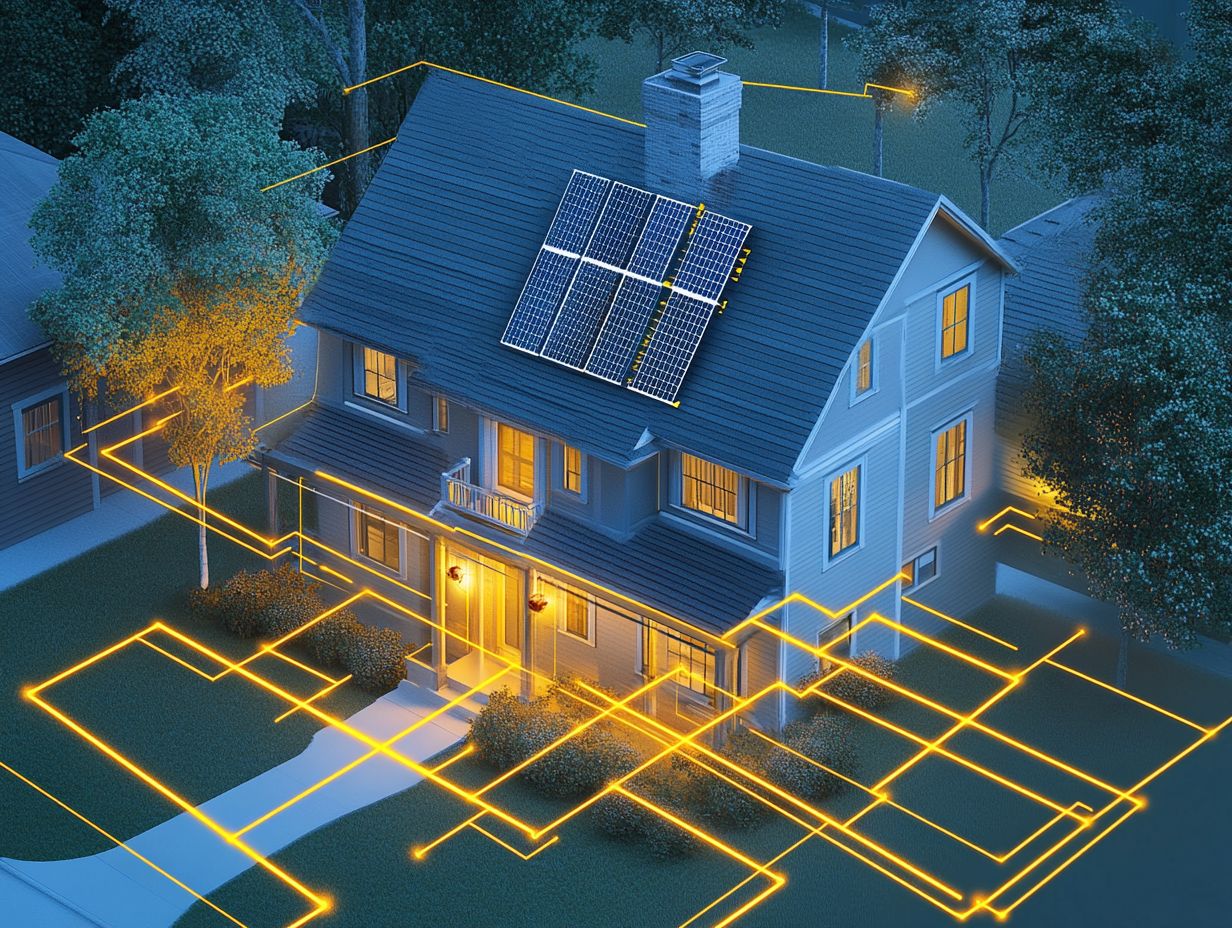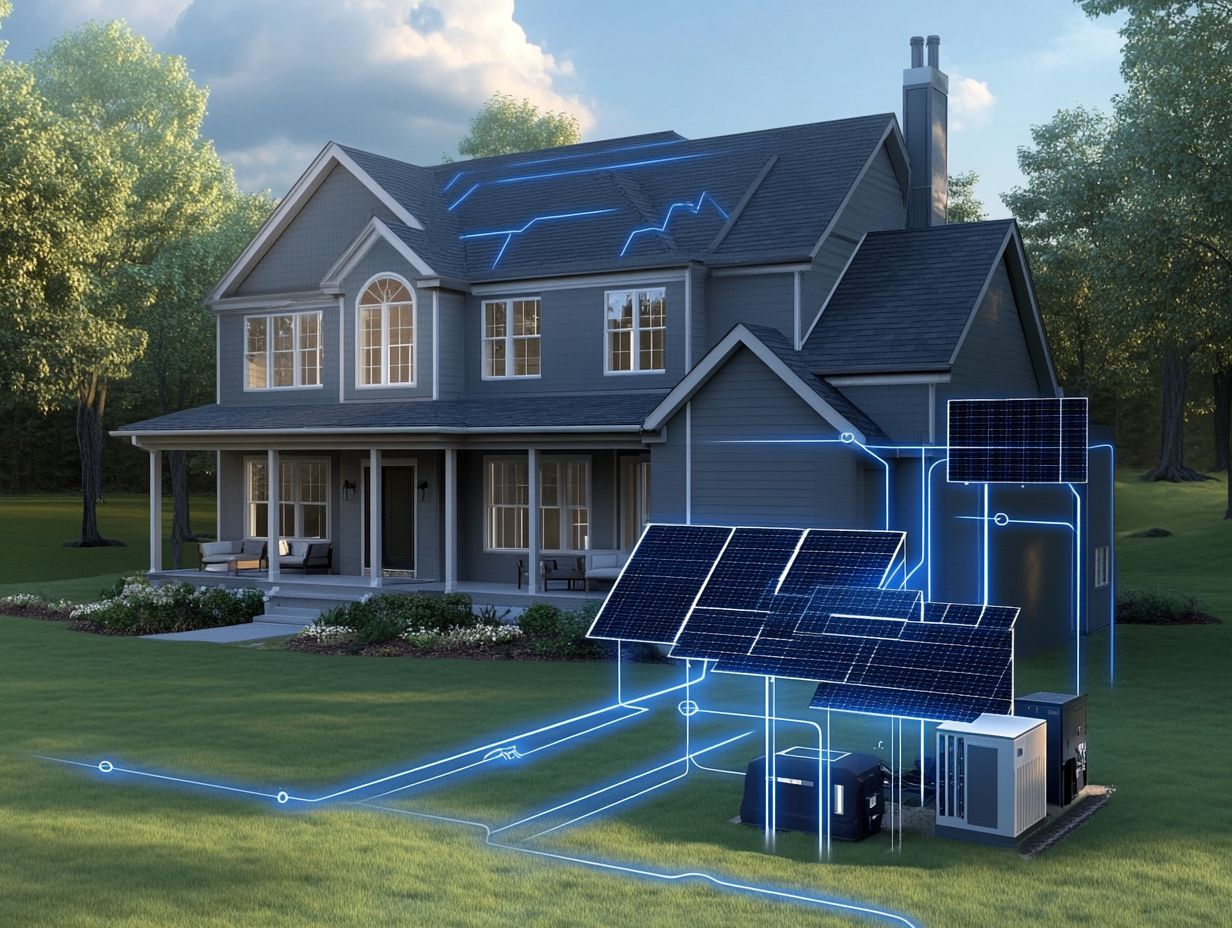Contents
- 1 How Solar Net Metering Works: An Exploration of Utility Rates and Grid Connection
- 2 Advantages of Solar Net Metering
- 3 Eligibility and Requirements for Solar Net Metering
- 4 Potential Challenges with Solar Net Metering
- 5 Getting Started with Solar Net Metering: A Step-by-Step Guide
- 6 Frequently Asked Questions
Solar net metering is a game-changing system that lets you tap into the power of solar energy while slashing your electricity bills and taking advantage of state incentives.
When you connect solar panels to the grid, you can send any extra energy you generate back to your utility meter. This means you earn energy credits that will help offset your future energy use and reduce your energy bills. It’s a win-win for both your wallet and the planet, though there are some eligibility requirements and potential challenges such as understanding net metering policies and utility rates to keep in mind.
Plus, there’s a handy step-by-step guide to help you get started with system installation and understanding solar incentives. So, whether you’re thinking about adding solar energy to your home with residential solar or just curious about this eco-friendly option, keep reading to discover how net metering can completely change the way you consume energy and manage energy efficiency.
What is Solar Net Metering? A Comprehensive Guide to Energy Generation and Net Energy Metering

Solar net metering is a pretty sweet deal that lets you, whether you’re a homeowner engaging in residential solar or a business owner with commercial solar, rack up credits for the extra energy your solar panels generate. This can significantly reduce your electricity bill and enhance your energy independence.
Here’s how it works: when your solar system produces more energy than you use, that surplus gets sent back to the grid, and your utility company rewards you with energy credits. It’s a clever way to boost renewable energy use, aid in demand-side management, and help you manage your energy consumption more effectively.
You can use those credits to offset your future electricity costs, which makes net metering an attractive option for anyone considering solar power and exploring energy return on investment. Keep in mind that net metering policies can differ from state to state, and these differences can significantly impact how appealing or feasible your solar energy investment will be due to varying regulatory frameworks.
- Some states roll out the red carpet with great rates for the energy you send back to the grid,
- while others can be a bit more stingy.
Understanding these policies is key, as they not only influence your potential savings but also play a crucial role in encouraging more people to adopt solar technology and engage with community solar programs. This shift away from fossil fuels is essential for creating a more sustainable energy future and supporting energy transition efforts.
Darghouth, N. R., Barbose, G., & Wiser, R. (2011). The impact of rate design and net metering on the bill savings from distributed PV for residential customers in California. Energy Policy, 39(9), 5243-5253. Link
How Solar Net Metering Works: An Exploration of Utility Rates and Grid Connection
Understanding how solar net metering works empowers you, whether you’re a homeowner or a business owner, to maximize your energy savings and fully tap into the benefits of solar technology.
Essentially, solar net metering connects your solar panels to the grid, allowing you to send any excess electricity back into the utility grid. Smart meters measure the energy your system produces and consumes, keeping track of it all.
The utility company then credits you for the excess energy you generate, which means you can enjoy some significant cost savings while also doing your part for a greener energy landscape.
Basic Principles and Components: Understanding Energy Generation and Solar Inverters
The basic principles of solar net metering are all about how solar panels and photovoltaic systems generate energy while allowing you to monitor your energy usage directly. At the core of this process are the solar panels installed on your property, which work their magic by converting sunlight into electricity through photovoltaic cells and ensuring the solar inverter functions optimally.
You can either use this electricity to power your home or business, or send it back to the grid, which means you need effective grid integration, including interconnection standards, to keep that energy flowing smoothly.
This integration not only maximizes the benefits of renewable energy sources but also helps keep the electric grid stable and supports grid reliability. As you harness energy from your solar setup, you’ll have the chance to monitor your consumption patterns and tweak your usage accordingly, enhancing energy efficiency.
With effective energy monitoring systems, you can gain insights into both your energy production and consumption, helping you optimize efficiency and save on costs. These technologies are vital for balancing demand and supply, ensuring that energy moves efficiently while promoting sustainable practices and addressing peak demand challenges.
Advantages of Solar Net Metering
The benefits of solar net metering go way beyond just saving money; they really help both the environment and your energy independence by encouraging energy equity and supporting renewable portfolio standards.
When you participate in solar net metering, you get to enjoy lower electricity bills thanks to the energy credits you earn from your solar setup and the potential for long-term savings through financial incentives.
Additionally, you’re doing your part to reduce your carbon footprint. This sustainable practice also supports the growth of renewable energy sources, making it a win-win for you and the planet while contributing to energy supply diversification.
Financial Savings and Environmental Impact

Solar net metering can really save you a chunk of change by cutting down how much energy you need to buy from the utility company and maximizing what you produce with solar technology. When you generate your own electricity, especially during those peak hours, you’re slashing the amount of energy you have to purchase, which means lower bills for you and potential net excess generation benefits.
By investing in solar panels and jumping on the clean energy bandwagon, you’re making a big difference in reducing your carbon footprint and supporting a sustainable future, while also benefiting from solar tax credits and performance-based incentives.
And it doesn’t stop at just saving on your monthly energy bills; you could also earn credits for any extra energy you send back to the grid. This can create a more stable income stream and help you manage your energy usage smarter. Plus, when you factor in potential tax incentives and rebates, the overall cost of going solar can drop significantly, enhancing your solar investment’s return.
On top of the personal financial perks, embracing solar energy means you’re playing a part in environmental stewardship and helping move us away from fossil fuels. It’s a win-win that contributes to a cleaner planet for future generations and supports broader energy transition efforts.
Eligibility and Requirements for Solar Net Metering
To fully benefit from solar net metering, you need to get familiar with the eligibility criteria and requirements set by your utility company and local regulations, including understanding installation costs and applicable warranties.
Typically, if you’re a homeowner or a business looking to join this program, you’ll need a qualified solar installation, like solar panels or photovoltaic systems that meet certain performance and safety standards, and consider energy storage solutions like battery backup for enhanced energy independence.
Additionally, knowing the utility regulations in your area will help you stay compliant and really maximize the benefits of your investment in solar technology, while potentially benefiting from subscription solar and virtual net metering options.
Qualifications and Necessary Equipment
To qualify for solar net metering, you’ll need some specific equipment and systems, mainly solar panels and maybe some energy storage solutions like battery systems if you want optimal performance. Smart meters are essential because they measure the energy you generate and consume, making sure your billing and energy credits from your utility company are spot on.
It’s also crucial to know about interconnection standards; they help you connect to the grid smoothly and safely, ensuring grid services are maintained efficiently.
Depending on where you live, you might find some cool incentives like tax credits or rebates that can help lighten your financial load. Plus, energy storage solutions like batteries let you stash away excess energy for later use, giving you even more independence and flexibility in managing demand responses.
There are also various financing arrangements, like loans and leasing options, that offer flexibility, so you can choose deals that fit your budget and energy needs, including solar leases and power purchase agreements. Solar energy has never been more accessible!
Potential Challenges with Solar Net Metering
While solar net metering comes with numerous advantages, there are a few challenges you should keep in mind to manage your energy effectively, such as navigating government policies and understanding evolving rate structures.
A common challenge involves navigating complex utility regulations that dictate net metering policies, which can differ quite a bit depending on where you live. On top of that, the billing process can sometimes feel a bit murky, especially when it comes to figuring out how excess energy is credited and applied to your electricity rates and understanding demand charges.
This can lead to some misunderstandings with your utility company that you definitely want to avoid, particularly in how consumption offsets and net energy metering factors are applied.
Limitations of Solar Net Metering and Possible Solutions

Even with all the perks, there are some limitations to solar net metering that could affect how well it works for you. Changes in utility incentives or restrictions from local energy policies might limit how much energy you can produce or mess with how your credits are calculated. This could take some of the shine off the financial benefits of investing in solar, particularly if feed-in tariffs are adjusted unfavorably.
By exploring alternative energy solutions and staying in the loop on energy policies, you can better navigate these challenges and boost your energy diversification, potentially tapping into distributed generation and microinverters.
It’s essential for you to keep an eye on your utility’s incentives and really understand the details of your energy contracts, since shifting regulations can impact your overall savings. Taking the time to research state-level energy policies or joining local advocacy groups can keep you informed about any changes that may affect your net metering situation.
Thinking about technologies like battery storage can also help you tackle some of these limitations. It gives you more energy independence and cuts down your reliance on grid power during those peak hours, enhancing your system performance and solar capacity utilization.
By actively engaging with the energy landscape, you can discover innovative ways to maximize your solar investments and move toward sustainable energy solutions.
Getting Started with Solar Net Metering: A Step-by-Step Guide
Getting started with solar net metering is easier than you might think—it just requires a few key steps.
- First up, assess your energy needs and explore the solar installation options, considering residential or commercial solar, that fit your goals for energy independence and sustainability.
- It’s a good idea to consult with a qualified solar provider who can evaluate your property for solar panel installation and chat with you about financing options.
- This includes everything from tax credits to solar power purchase agreements (PPAs), net excess generation benefits, and potential savings.
This entire process facilitates your transition to renewable energy and achieves energy independence but also puts you in a great position for long-term energy solutions, electricity savings, and financial benefits through solar power and utility meter management.
Steps to Install and Activate Solar Net Metering
The installation process for solar net metering and photovoltaic systems can be pretty straightforward if you stick to some well-defined steps. Start by selecting the right solar panels and finding a solid installation team to ensure everything performs optimally. Consider installation costs and available solar tax credits to optimize your solar investment.
Once your residential solar or commercial solar setup is in place, you’ll want to coordinate with your utility company to establish that all-important grid connection and activate the energy monitoring systems that will accurately track your energy generation and consumption. This seamless integration, along with smart meters and solar inverters, is key to maximizing the benefits of solar net metering and ensuring peak performance of your solar array.
To kick off your project, take a moment to evaluate your energy needs and do a bit of research on the various solar panel options out there, including microinverters and battery backup systems. Consider factors like solar efficiency, cost, and warranties. Teaming up with a reputable installation company that specializes in solar energy systems is also a smart move, as their expertise will really come in handy, especially when considering government policies and state incentives that might apply.
After you’ve picked your panels and assessed your solar capacity, it’s essential to have a chat with your utility company about net metering policies, feed-in tariffs, and interconnection standards to ensure everything goes smoothly. Implementing energy monitoring systems will give you real-time data and insights, helping you adjust your energy habits, optimize consumption offset, and further enhance the efficiency of your solar investment.
Frequently Asked Questions
What is solar net metering?

Solar net metering is a billing arrangement that allows solar energy system owners to receive energy credits for the net excess generation of electricity they produce and send back to the grid. These energy credits can then be used to offset future electricity bills, contributing to long-term savings.
How does solar net metering work?
When a solar energy system generates more electricity than a household or business needs, the excess is sent back to the grid, causing the utility meter to run backwards, essentially giving the owner credit for the electricity they contribute. This credit, known as net energy metering, can then be used to offset any future electricity usage from the grid.
Is solar net metering available everywhere?
Solar net metering is available in most states in the United States and in many countries around the world. However, specific policies and regulations may differ, so it is important to check with your local utility company or government to see if it is available in your area and how it fits into the local regulatory framework.
What are the benefits of solar net metering?
Solar net metering allows solar energy system owners to achieve electricity savings by using the excess energy they generate to offset their future usage from the grid. It also promotes the use of renewable energy, supports solar expansion, and helps reduce the demand for non-renewable sources of electricity, thereby lowering the carbon footprint and improving overall environmental impact.
Are there any drawbacks to solar net metering?
One potential drawback of solar net metering is the possibility of policy changes, such as decoupling or caps on the amount of credit that can be received. This can vary by location and may affect the overall financial benefits and ratepayer benefits of solar net metering. It is essential to stay informed and regularly check for updates or changes in policy support and utility rates.
Can I still use solar net metering if I have a battery storage system?
Yes, it is possible to use both solar net metering and a battery storage system. However, it is important to check with your local utility company and energy providers to see if they allow both options and to ensure your system is set up properly to take full advantage, thus optimizing energy storage and improving return on investment.

